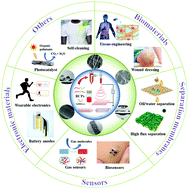A comprehensive review of electrospinning block copolymers
Abstract
Electrospinning provides a versatile and cost-effective route for the generation of continuous nanofibres with high surface area-to-volume ratio from various polymers. In parallel, block copolymers (BCPs) are promising candidates for many diverse applications, where nanoscale operation is exploited, owing to their intrinsic self-assembling behaviour at these length scales. Judicious combination of BCPs (with their ability to make nanosized domains at equilibrium) and electrospinning (with its ability to create nano- and microsized fibres and particles) allows one to create BCPs with high surface area-to-volume ratio to deliver higher efficiency or efficacy in their given application. Here, we give a comprehensive overview of the wide range of reports on BCP electrospinning with focus placed on the use of molecular design alongside control over specific electrospinning type and post-treatment methodologies to control the properties of the resultant fibrous materials. Particular attention is paid to the applications of these materials, most notably, their use as biomaterials, separation membranes, sensors, and electronic materials.



 Please wait while we load your content...
Please wait while we load your content...